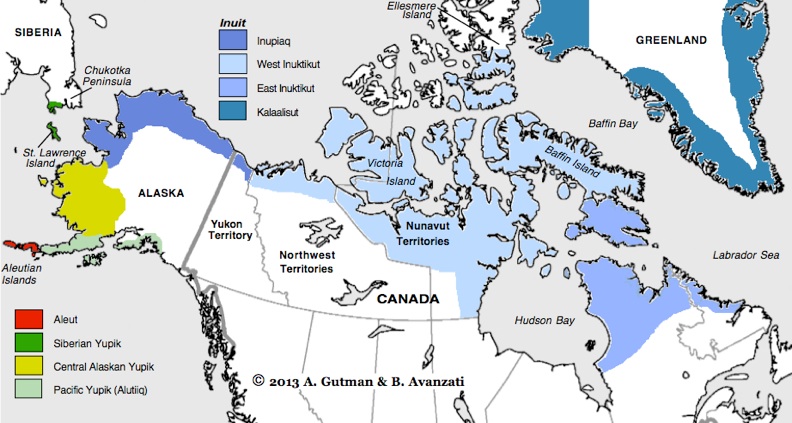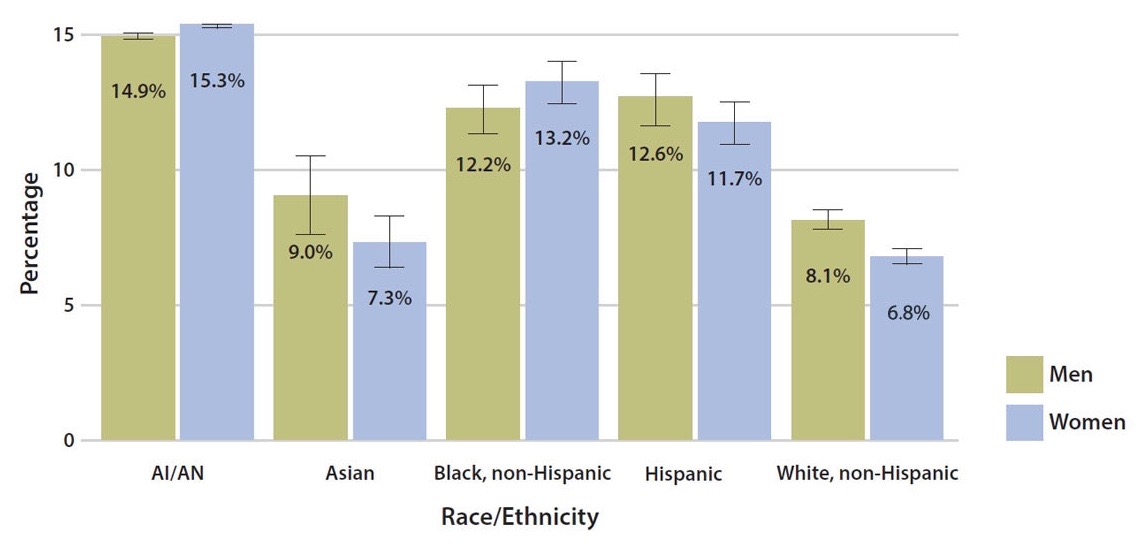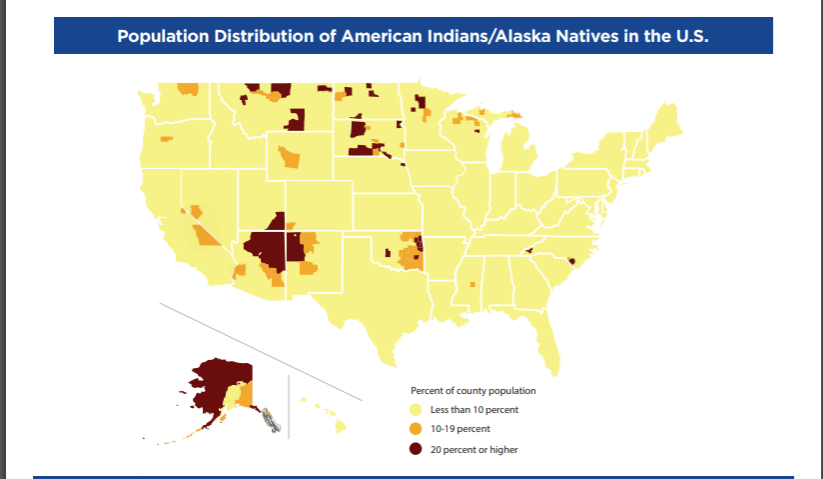Native American Health
Southern Eskimo/ Aleut, Alaska
Makayla Moore

Who
American Indian and Alaska Natives are contemporary descendants of the Indigenous people of North America (Gone & Trimble, 2011). The Indigenous people who reside in modern day Alaska are of Athabascan, Tsimpsian, Tlingit, Haida, Eskimo and Aleut descent.
Native American Health focuses on some of the health disparities that Alaska Natives are facing today. Diabetes, a main health concern, is the first focus. With such alarming rates, it brings about a concern as to what is causing Diabetes to be so prevalent in these communities. I chose Diabetes and mental health as key examples of health issues in this case because I was able to find a direct correlation through the various forms of research. Diabetes and mental health are factoring examples of issues that have lead and continue to be a link to disempowerment.

Is Diabetes a Genetic Predisposition?
Diabetes is the result of too much sugar in ones blood stream. This disease has become an epidemic affecting a majority of Indigenous peoples. With the Indigenous peoples rate of Diabetes being as high as it is, this raises questions in relation to diabetes being a possible genetic predisposition. Are Alaska Natives liable to suffer from Diabetes due to their genetic makeup ? Image 2 illustrates a bar graph containing data that shows the percentage of Diabetes in various groups. This data shows us that racial/ ethnic groups, male and female, have higher rates of Diabetes. Unlike some traits, diabetes seems to be inherited from a complicated rather than simple pattern yet, some people are born are more receptive to develop diabetes than others. Type 1 Diabetes is an autoimmune disorder in which the body attacks its pancreatic beta cells preventing the production of insulin (American Diabetes Association). This form of Diabetes is attributed to both inherited risks and external triggers. Other factors can include ones diet or an even an infection. The search for both the problem and solution to genetic and environmental risk factors are ongoing (Kharroubi & Darwish 2015). A majority of Type 2 diabetics are either overweight or obese. The Inherited factors are just as important but the genes involved remain poorly defined. Type 2 Diabetes can in fact be hereditary. While T2 Diabetes can be hereditary, this does not mean that if your parents has (or had) Type 2 Diabetes, you are guaranteed to develop it. Instead, this highlights a greater chance of developing Type 2 Diabetes. Genetic predisposition increases the chance of a disease repeating itself in offspring within a species or population. The research on both Type 1 and Type 2 Diabetes suggest that, you can inherit the risk. Understanding that Diabetes development involves the interaction between genetic and non-genetic factors, this furthermore supports the idea that Diabetes is not a genetic predisposition, entirely. Jennifer Poudrier, from the University of Saskatchewan, discusses her thoughts on “The Thrifty Gene Theory.” This theory is based on the evolutionary notion that allowed them to store fat during hunting/ gathering time eras. This is also being used as a simplistic explanation for the high account of noninsulin dependent diabetes mellitus occuring in contemporary populations (Poudrier, 2007). Although Diabetes and obesity has been linked to both, environmental and lifestyle factors, (i.e age, stress, poor nutrition, sedentary lifestyles, low socioeconomic status, social marginalization) scientific research shows that there are in fact genetic elements involved in the high linkages between Indigenous peoples (Poudrier, 2007). Poudrier’s work argues that the existence of the thrifty gene being a biological entity is open and unfinished.
Mental Health
Mental health can be imagined as an umbrella covering a wide range of conditions that affect one's mood, thinking and their behavior. According to the United States Department of Health and Human Services Office of Minority Health, a few years ago suicide was the second leading cause of death for American Indian/ Alaska Natives between the ages of 10 and 34 (OMH, 2018). More research showed that they are 50% more likely to experience feelings of nervousness or restlessness in comparison to their non hispanic white counterparts (OMH, 2018). Alarming rates like so raises a red flag. Why are Alaska Natives susceptible to suffering from mental health issues? Racial/ ethnic, gender and sexual minorities often suffer from poor mental health at the hands of inaccessibility of high quality mental health care services, cultural stigma surrounding mental health care, discrimination and overall lack of awareness about mental health. Working to meet the health needs of Alaska Natives, the Alaska Native Tribal Health Consortium (ANTHC), Behavioral Health Department works with tribal health organizations throughout the state to help build the overall health of Alaskans and healthier communities. Higher rates of substance use disorders, PTSD and suicide in Alaska Native communities have all been correlated to historical trauma that was forced upon them. According to American Indian and Alaska Native Mental Health: Diverse Perspectives on Enduring Disparities, historical trauma is the collective intergenerational psychosocial legacy of colonization or other forms of mass oppression (Gone & Trimble, 2011). Historical trauma came in the form of Indigenous people being victims of forced removal from their land, government operated schools in which they were prohibited from seeing their parents, spiritual practices and culture in general. While mental health care utilization rates for Alaska Natives are lower than most, there is reasoning behind this. Lack of participation is likely the result of factors such as stigmatization of mental health, little to no culturally trained providers, lack of available resources, economic barriers, lack of awareness, and lack of effective intervention strategies.
Referring to Image 3, this map shows the population distribution of American Indians/ Alaska Native in the United States. The percent of county population does not surpass 20% or higher. This is a great visual representation of isolation and simply being outnumbered greatly. The following research section on deprivation and disempowerment digs deeper into humans needing to feel a sense of relatedness through a social connection. Without meeting this psychological need, they become ill. This further examines the relation between mental health status being the result, along with many other contributing factors as mentioned above, of social isolation within a community. Isolation in general has been linked to many mental health disparities. When it comes to American Indians and Alaska Natives, we must consider and examine an entire population feeling isolated toward the rest of society.

Deprivation & Disempowerment
Disparities in health have existed among Alaska Native populations since the time of first contact with Europeans. Many of the inequality and complications are the result of demographic, social, health and health care disparities. Alaska Natives are exposed to trauma in various forms. According to “Anthropology and the American Indian/ Alaska Native Health Crisis”, the current epidemic of health problems in Alaska Native populations start with forced compliance (Jones, 2006). Referring back to image 3, the condensed population distribution can be correlated to forced compliance and the idea of social isolation as previously mentioned. Broken down further, previous and modern day forced compliance has caused Indigenous people to condense their population and live in smaller clusters. While this may be promoting social connectedness among their small tribal communities, it isn’t overall. Perhaps if there were larger percentages of American Indians and Alaska Natives evenly distributed across the United States they would have a greater sense of power and control amongst themselves and their residential areas. Hegemony, both culturally and medically, is influential over others through social, cultural, ideological or economic factors that are exerted by a dominant group. In short, power. Self- Determination Theory is an approach to human motivation and personality that uses traditional empirical methods while employing an organismic metatheory that ‘highlights the importance of humans’ evolved inner resources for personality development and behavioral self-regulation. This theory completes a study on people’s tendencies to grow and their innate psychological needs that relates to their self-motivation and personality integration (Ryan, Deci, 2000). This theory recognizes and identifies 3 basic psychological needs in which they consider are universally required for humans to thrive (Ryan and Deci 2011). Autonomy, self government, competence, capability of doing something efficiently, and relatedness through a social connection are psychological needs that that all humans need in order to thrive in some manner. This study confirms that psychological health is at risk if any of the 3 needs are not met. In relation to this, when people lack autonomy they feel that they are being dominated by others. Both their mental and physical health deteriorates due to social, economic and or political circumstances.
Taking Action: What Can Be Done?
Traditional Cultural Practices
The “Culture as treatment” hypothesis is a claim by a significant number of AI/AN community members who are in favor of traditional Indigenous worldviews. They are in favor of the return to traditional Indigenous worldviews and practices in itself being an efficacious mental health intervention. Gone and Trimble’s research on “Diverse Perspectives on Enduring Disparities” highlights the importance of cultural reclamation as proper treatment for mental health problems (Gone & Trimble, 2011). Allowing Indigenous people to reclaim their culture will place them in positions to fulfill the 3 basic psychological needs as previously discussed; autonomy, competence and relatedness. Ryan and Deci refers to the basic need as an energizing state that conduces toward health and well-being. However, if the needs are not satisfied, it contributes to ill-being (Ryan and Deci, 2000). Since mental health is culturally embedded, beliefs about the nature of mental health problems and the acceptability of alternative solutions can separate ethnic minority clientele from mental health providers. Some of these cultural views are supernatural models, natural and religious explanations (Gone & Trimble, 2011).
Comprehensive & Coordinated Services
Providing comprehensive services comes in the form of disseminating culturally appropriate mental health information and services to Alaska Natives. It is important to understand, from a cultural perspective, minority groups. Doing so could lead to a potential outcome of higher utilization rates for mental health services.
Community Control
Cheung and Snowden suggests that community control should be approached through active advisory board participation with solid community representation (Cheung & Snowden, 1990). Community representation is key because it allowed minorities the opportunity to be a voice, with a larger platform, to for other minorities. This could decrease the high rate of social isolation a lot of Indigenous groups in the United States face.
Sources:
Image 1: "Alaska Native Communities." http://www.languagesgulper.com/eng/Eskimo.htmlImage 2:"Diabetes and American Indians/Alaska Natives." https://minorityhealth.hhs.gov/omh/browse.aspx?lvl=4&lvlid=33
"American Indian and Alaska Native mental health: diverse perspectives on enduring disparities”, Joseph Gone & Joseph Trimble, 2011)." https://www.ncbi.nlm.nih.gov/pubmed/22149479
Type 2: http://www.diabetes.org/diabetes-basics/type-2
Diabetes mellitus: "The epidemic of the century" (Kharroubi & Darwish 2015). https://www.ncbi.nlm.nih.gov/pmc/articles/PMC4478580/
“The Geneticization of Aboriginal Diabetes and Obesity: Adding Another Scene to the Story of the Thrifty Gene” (Jennifer Poudrier, University of Saskatchewan, 2007).
The American Psychiatry Association (2018). https://www.psychiatry.org/psychiatrists/cultural-competency/treating-diverse-patient-populations/working-with-native-american-patients
Image 3:"Population Distribution Map." http://sedac.ciesin.columbia.edu/data/collection/usgrid/maps/gallery/search
“Self- Determination Theory and the Facilitation of Intrinsic Motivation, Social Development, and Well-Being” (Richard M. Ryan and Edward L. Deci, 2000).
“The Persistence of American Indian Health Disparities” (David S Jones, MD, PhD, 2006). https://www.ncbi.nlm.nih.gov/pmc/articles/PMC1698152/